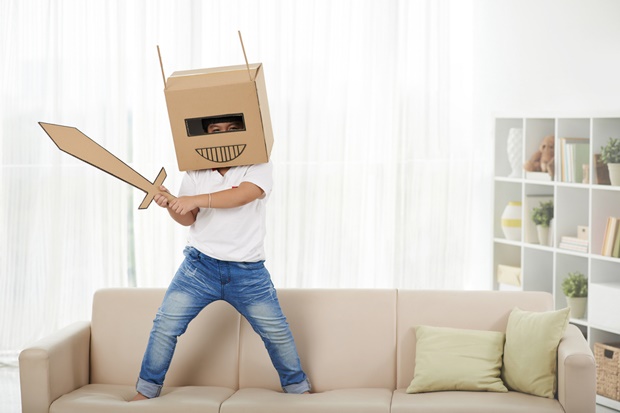
You don’t have to spend a fortune on toys and games to keep your child busy. You also don’t need to support toy manufacturers that use harmful materials, processes and labour practices. Why not give your child an environmentally friendly toy that teaches her something, while at the same time does some good for the world we live in?
Here are some interesting and easy ways to turn household objects into entertaining toys and games for your child.
Around the house
What’s in the box?
Sometimes it’s not what’s in the box that can be great fun, but the box itself.
Before throwing empty boxes away, think of the hours of imaginative play that it could provide. Children love a big cardboard box for crawling through, sitting in and drawing on. A huge one makes a fabulous house. A smaller one is perfect for throwing beanbags into.
For a couple of weeks, save all your empty grocery cartons like cereal boxes, egg cartons and plastic bottles with tops.
Clean them up, glue down the flaps of the cardboard cartons, and you have all the stock you need for a grocery shop.
You can use old coins or plastic money for added authenticity, and older children can make their own banknotes. This is great for teaching simple maths.
Tube tales
Reaching the end of the roll doesn’t mean you should through the cardboard tube out. The cardboard rolls from toilet paper, kitchen roll and wrapping paper give hours of fun. Your baby will love watching things disappear and reappear by experimenting with rolling things through them, or shouting down them.
Cardboard tubes also make perfect fancy dress accessories for your toddler’s make-believe games. Swords, telescopes or elephant trunks can easily be made from cardboard tubes - the possibilities are endless!
Playful paper
Old news can still tell many stories. Fold old newspaper into paper boats and take them down to a pond for some fun. There are great instructions on www.dltk-bible.com/crafts/mboat, or you could trawl the internet for some other fun origami projects.
Mini gardens
Create a mini ecosystem with a big flat dish or a foil tray as the container for a miniature garden. Let your toddler fill it with soil. Decorate it with pebbles, twigs, grass and whatever else you can find. A jam jar lid sunk into the soil makes a great pond.
Paper balls
Help your child crunch up pages of old magazines to make paper balls. Babies like the crackly noise this makes. Toddlers can throw them around to their hearts’ content without breaking anything. Preschoolers can practise aiming at targets.
Free fun
The internet has some great activities that can be downloaded for free. You can print them out on recycled paper and your little one can enjoy hours of fun.
The website www.thetoymaker.com has some amazing paper toys that you can print, cut out and put together. Whether your little one fancies fairies, animals or pirates, it’s all there. You even download a few colouring-in pages from www.coloringbookfun.com for your budding Picasso!
Obstacle course
Create an adventure in your garden or lounge by setting up an obstacle course. Let your crawler climb over cushions and pillows. Help him step from stepping stone to stepping stone, crawl through a cardboard box, or balance on a bench.
Housy housy
Making a house from pushed-together furniture and draped blankets is an all-time favourite activity. Provide the necessary sheets, cushions and so on, and make sure the whole thing is stable!
Once the shoe fits
You needn’t throw away old shoe boxes. They make great “bricks” for little ones to build with. Just tape the lids on, add a bit of paint and you could make a completely recycled little house for your child. Shoe boxes also make great miniature beds for your little girl’s dolls.
Water
Nothing entertains a baby or toddler as much as water. A plastic basin makes a wonderful baby paddling pool, and will give your toddler hours of fun as he practices pouring and splashing. Let him dip a bucket or watering can in it and water the garden. Make paper boats to float in it. Just remember safety first - stay close by at all times!
When you don’t have time to create
When you don’t have the time to make toys out of everyday items and need to buy a toy or game for your child, try to follow these tips:
Buy locally
Products that are manufactured locally don’t have as far to travel to reach the shops as a product made in China, for example. By buying a locally made product, you are saving on the energy needed to transport it.
Buy natural
Products made from sustainable, recycled and natural sources are always a good buy. Wooden toys are fantastic, and they last longer than plastic toys. Avoid anything that is made with PVC. This material releases toxins into the environment from the second it is made.
Battery free
It’s almost become second nature for a toy to be battery operated; the kids seem happy, but all that battery-powered noise just isn’t worth it. Batteries that are thrown away release terribly harmful chemicals. If you do have toys that are battery-operated, consider investing in rechargeable batteries to eliminate waste.
Buy fair trade products
Your child shouldn’t be playing with a toy that was made by someone else’s child in terrible conditions. More and more people are becoming aware of the horrendous conditions that many workers (most of them children) manufacture our everyday products under.
When buying a toy, look for a fair trade certification to be sure that no child labour was used in its manufacture.




 Publications
Publications
 Partners
Partners














